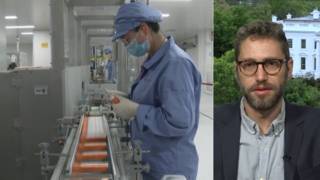
Guests
- Sana Jaffreydirector of the Institute for Policy Analysis of Conflict in Jakarta.
- Dicky BudimanIndonesian epidemiologist at Griffith University in Australia.
As the World Health Organization warns over 100 million more people will be infected with COVID-19 by early next year as the Delta variant continues to rapidly spread, we look at Indonesia, which has become the epicenter of the pandemic in Asia. Over the past 28 days, Indonesia has recorded 43,000 deaths, more than anywhere else in the world. More than half of the deaths have occurred in the past two months as the Delta variant overwhelmed hospitals across the country. Sana Jaffrey, director of the Institute for Policy Analysis of Conflict in Jakarta, says the public debate is largely focused on whether to protect public health or allow economic activity to continue. “It is unfair that we are still stuck in this discussion when, in Western countries, people are getting vaccinated or choosing not to get vaccinated,” Jaffrey says. “Indonesia is not able to break out of this trap of these two options because there just isn’t enough supply of vaccines in the country.” We also speak with Dr. Dicky Budiman, an Indonesian epidemiologist, who says it’s important to combine vaccination with other measures such as testing, tracing and isolation. “We have to combine the strategies,” he says.
Transcript
AMY GOODMAN: This is Democracy Now!, democracynow.org, The War and Peace Report. I’m Amy Goodman, with Nermeen Shaikh.
As we continue our coverage of the pandemic, we turn to Indonesia, which has become the epicenter of the pandemic in Asia. Over the past 28 days, Indonesia has recorded 43,000 deaths. That’s more than anywhere else in the world. This brings Indonesia’s overall death toll to over 112,000, though public health experts say the true death toll is likely many times higher. More than half the deaths have occurred in the past two months as the Delta variant overwhelmed hospitals across Indonesia.
We’re joined by two guests. Sana Jaffrey is director of the Institute for Policy Analysis of Conflict in Jakarta. She recently wrote an article headlined “How the Global Vaccine Divide Is Fueling Indonesia’s Coronavirus Catastrophe,” published by Carnegie Endowment for International Peace, where she serves as a fellow. And we’re joined by the Indonesian epidemiologist Dr. Dicky Budiman, who is at Griffith University in Australia, joining us from Brisbane.
Let’s begin with Sana Jaffrey in Jakarta. Let’s begin with the headline of your piece, “How the Global Vaccine Divide Is Fueling Indonesia’s Coronavirus Catastrophe.” Explain.
SANA JAFFREY: Well, for the last year, more than a year, epidemiologists — like Pa Budi, Pa Dicky — and public health experts have been debating with the government options to contain this pandemic. And there are only two options available. One is saving the economy by not imposing the lockdown or mobility curbs that are necessary to contain the virus, or imposing them and then having Indonesia, 60% laborers who are in the informal sector, suffer as a result. And this is a very heated debate. This is a very — has been going on for a long time.
And it is unfair that we are still stuck in this discussion, when, you know, in Western countries, people are getting vaccinated, or choosing not to get vaccinated despite the fact that there is an abundant supply of vaccines, and Indonesia is not able to break out of this trap of these two options because there just isn’t enough supply of vaccines in the country, not because they don’t want it, but because they’re just unable to access it even if they want to purchase it.
NERMEEN SHAIKH: Sana Jaffrey, explain what you think needs to be done to expand vaccine access in Indonesia.
SANA JAFFREY: So, globally, there are — people have — you know, given the condition in Indonesia and the news that’s come out, it’s a sort of a [inaudible] have contacted American [inaudible] asked what it is he can do, what can he send. And I often tell them that, you know, the best thing you can send, for Indonesia, is a letter to your congressmen and women and tell them that they need to, first of all, make sure that the surplus doses that are lying across CVSes and Walmart and Walgreens across the United States, about 26 million doses that are about to expire, you know, an effort is made to collect them and send them to countries like Indonesia that could use them right away. Secondly, you know, write to them, urge your lawmakers to waive a patent that could make production available and technology transfer available to countries who could make their own vaccines and increase global supply all over the world. Those are the two things that need to happen, apart from arranging donations, which are really a band-aid for a much larger problem.
NERMEEN SHAIKH: Dicky Budiman, I’d like to bring you into the conversation, Indonesian epidemiologist at Griffith University. Could you respond, also talk about what you think needs to be done to expand vaccine access? And also this question — you predicted more than a year ago that Indonesia would become an epicenter of the pandemic. Explain how and why.
DR. DICKY BUDIMAN: Yeah. First, about this prediction, I was predicting, early March 2020, not only Indonesia, but also India and also Brazil, because I was in the global health practice for almost 20 years, and I work in ASEAN, in Islamic Cooperation, and also UNDP and WHO. So, the base of the assumption made because the health infrastructure, they both are — I mean, three of them is almost quite similar. Especially, let’s say, the fragile of the health infrastructure in Indonesia, we can see even before the pandemic. And also, you know, the situation, the capacity of the testing and also to detect the early cases, also been there since the beginning of the pandemic.
And, of course, then, the other thing is about the health system and also how the leadership in each level of pandemic — of the government also will be influenced of this prediction. And, of course, then, as we know, actually, if Indonesia has proper testing and tracing, actually, the prediction as the epicenter of even, let’s say, early of — end of the July, they already become the epicenter of the COVID-19. But, of course, then, the remaining problem still is the poor testing and tracing capacity still now. Then, even under this condition, they already become the epicenter of the — in Asia.
So, then, it’s about the vaccination program in Indonesia. I always remind the government and also the public that a vaccine is not the sole strategy. It’s not the only solution for this pandemic. We have to — especially with dealing with the Delta variant, we have to combine the strategies. But the first hierarchy should be in testing and detection, the case detection. That’s very important. So, we call it — in Indonesia, we call it three T: the testing, tracing and treatment — of course, including isolation. And then we have the five M, which is social distancing, masks and everything there, and also then vaccination.
The problem so far is that — I always criticize the government. Of course, compared to others, the vaccination program in Indonesia is much, much better — I mean, compared to testing and tracing and also the social distancing intervention. But, again, due to our huge population and also the many islands we have, and remote islands, and, of course, the stock of these vaccines is not enough yet. And the problem with this also is that we now are facing this Delta variant. And we know this vaccine — I mean, the Sinovac, and we have even now Sinopharm and also AstraZeneca — of course, is less effective if we compare with the messenger RNA.
So, that’s why we have to combine those three strategy tools effectively; otherwise, the number of morbidity and mortality will be still increasing in the middle of this vaccination program. That’s one of the — I mean, the very important mention that I always remind to the government.
AMY GOODMAN: Dr. Budiman, you mentioned Sinovac and Sinopharm. Those are the Chinese vaccines.
DR. DICKY BUDIMAN: Yes.
AMY GOODMAN: They are clearly not as effective, but they got there very early, which was extremely significant. It does bestow some immunity. But doctors and nurses, can you talk about the death toll among them, and what it would mean to supplement with these mRNA vaccines, like Pfizer and Moderna, the significance of this, the access that the Indonesian government has to these vaccines and the — we asked the same question to our guest in India: what it would mean if these waivers were put in, that change the calculus of how Indonesian, Indian companies can start to produce these vaccines in bulk?
DR. DICKY BUDIMAN: Yeah. I have to fairly say that at a certain level, the Sinovac and Sinopharm, it has their protection, regarding the, let’s say, even the Delta variant, but, of course, less effective. But the meaning of “less effective” doesn’t mean not effective, because even among the healthcare workers, still we can find that there’s many of them is protected and show the mild or even asymptomatic when they get the COVID-19, I mean, Delta variant. But, of course, if we compare to this messenger RNA vaccine, of course, the Pfizer and Moderna has a bigger protection against the new variant.
But the problem with this messenger RNA is for Indonesia, let’s say, because the cold chain is not really user-friendly for us, especially — it’s only, let’s say, for the big cities, like in Java and some — only some cities in, let’s say, in Sumatra and also Sulawesi. But for the rest of Indonesia, it’s very difficult to use this kind of vaccine platform. So that’s why the technology that China used on their vaccine is user-friendly for a less developed country or developing country like Indonesia. So the problem now is how we can make a hub for the effective vaccine like messenger RNA, but then, of course, regarding the cold chain, we can make sure that it’s appropriate and easy to use on the field for a country like a developing country like Indonesia. That’s another question and also another challenge for this messenger RNA.
But, of course, we can have another strategy. Let’s say we can — at least for the most vulnerable one, we can also put in big city. Then we can call them and give this vaccine. I also the one who also advocate and also advise the government to have and to choose the messenger RNA for the booster for the healthcare worker, because, again, we have to use the most effective one to protect the most vulnerable one. That’s my advice. But, again, the problem is, for the rest of Indonesians, then it’s the distribute — the geographical situation, of course, the infrastructure also becomes — still becomes our main problem. So, in my opinion, and so we have to still combine this high tech of vaccine technology and also the most friendly-use ones.
NERMEEN SHAIKH: Sana Jaffrey, you’ve written about this, the relative collapse of the Indonesian healthcare system in dealing with COVID patients. Can you talk about what patients have been doing, where they’ve been accessing healthcare, and then, also, just like we heard about India and many other countries in the world, the increasing numbers of poor people in Indonesia who have been pulled into poverty because of the pandemic and lockdowns and so on?
SANA JAFFREY: Yes. When I was listening to Barkha talk about her father, I was thinking about all the families, including mine, who have lost our elders after just one vaccine jab, and the struggle that people who have lost their loved ones have to go through, first to find treatment, and then to just wait at home for oxygen tanks. [inaudible]
The virus is spreading outside of big cities, like Jakarta and cities in Java, to areas that are far more remote and where the health system is even more vulnerable. I know, personally, of my family struggling to find oxygen tanks in a remote mining town in Riau Islands, where the oxygen ran out over the weekend and came on Monday. So, for two days, people just watched their loved ones struggle, and many didn’t make it. And these are sort of the stories that are coming out now, and they’re coming out late because those areas tend to be far behind the big cities in terms of how they report numbers. And so, that’s a — you know, that’s a struggle across.
You know, there is no way that Indonesia could have completely avoided especially this kind of scenario with the Delta variant. But as, you know, Pa Dicky also mentioned, with some precautionary measures, especially with improving the detection and surveillance capacity, the impact of this kind of pandemic could have been contained, especially because Indonesia, relative to other developing countries, actually has a pretty widespread health system in the form of community health centers that serve as the first site of testing and also triage and quarantining or helping people find out if they have COVID or not, and then referring them to hospitals. So, this could have been managed a lot better.
But in terms of trying to save the economy, the government was very hesitant from the beginning to impose restrictions. The irony, of course, is that, you know, even with the measures that they took to protect the economy, it hasn’t done well. You know, Indonesia is sort of reeling from its first recession in 22 years. The World Bank downgraded Indonesia’s status back to lower-middle income. And then, over the past year, 1.6 million people have lost their jobs. And two point — almost 3 million people have been pushed below the poverty line. So, what we’re seeing in Indonesia today is sort of a worst of both worlds.
NERMEEN SHAIKH: Sana Jaffrey, could you also talk about the impact of the pandemic on children, you know, which is not something that has been so prevalent in other parts of the world, although it has been in some parts, including Brazil? Why are children being so badly affected? How is that understood? Now it’s reported that 12.5% of cases in Indonesia are among children.
SANA JAFFREY: I would actually refer this question to Pa Dicky, who is much more knowledgeable about how the disease affects children. But I would say that, you know, in terms of Barkha mentioning from India that the schools were closed, in Indonesia, too, the schools have been closed. And we are in the same situation, where the children [inaudible] affected is because they had [inaudible] into school in a year, especially children from much more underprivileged background because they don’t have access to the technology that would connect them online. In terms of why the virus is affecting children more, I would refer to, you know, the expert on this show, which is Pa Dicky.
AMY GOODMAN: Dr. Dicky Budiman had to go, but I want to thank you, Sana Jaffrey, director of the Institute for Policy Analysis of Conflict in Jakarta, Indonesia. And our condolences on the death of your father [sic] in the Indonesian islands of Riau. And we will link to your article, “How the Global Vaccine Divide Is Fueling Indonesia’s Coronavirus Catastrophe,” published by the Carnegie Endowment for International Peace, where she serves as a fellow. And we want to thank Dr. Dicky Budiman, who is an Indonesian epidemiologist and MD at Griffith University in Brisbane, Australia.
Coming up, historian John Barry joins us, author of The Great Influenza: The Story of the Deadliest Pandemic in History. He talks about what history tells us about the Delta variant and the variants that will follow. Stay with us.













Media Options